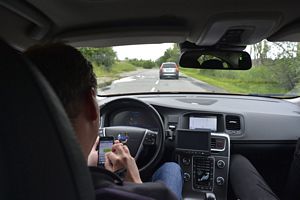|
By accessing or using The Crittenden Automotive Library™/CarsAndRacingStuff.com, you signify your agreement with the Terms of Use on our Legal Information page. Our Privacy Policy is also available there. |

Volvo don't want you to crash your Volvo ever
|
|---|
|
|
Volvo don't want you to crash your Volvo ever
Matt Hubbard
Speedmonkey
July 4, 2013
Volvo have always been at the forefront of safety but they've just come up with a load of innovations which they hope will make future Volvos uncrashable. Check this lot out
Pedestrian detection in darkness
This will be installed on the new XC90 in 2014. It will be able to identify pedestrians and brake the car automatically, even when the puny human behind the wheel hasn't seen the nutters walking along country roads at night.
Animal detection
This will become available post-2014. The challenge is to tell the difference between different sized animals. In the UK deer are a huge problem, in Sweden and Canada it is the moose. It is probably not wise to have cars braking every time a rabbit wanders into its path.
Road edge and barrier detection with steer assist
25% of all accidents in Volvo cars are caused by the car leaving the road. In the US and Sweden cars leaving the road account for half of all fatalities. So your Volvo will sense you are just about to leave the road, because you have fallen asleep/are fiddling with the controls/are stupid, and will take control of the steering to guide you back on it. This tech is in the testing phase.
Adaptive cruise control with steer assist
Taking adaptive cruise control one step further. This works extremely well in current Volvo cars. Steer assist means you ping the car in front and follow it.
Car 2 Car communication
This is basically supplying the driver with data from roadside monitors and from cars in front warning of slippery surfaces, queues etc. It sounds like a great system but must be horrendous to implement. This is in the 'trying it out and testing it' phase.
As well as the above areas which they are working on and have defined arrival times Volvo have another load of technologies in development. These are many and varied. See the list below, which is taken straight from the press release. Some of these technologies are basically adaptations of the stuff above.
Examples of application areas for the new technology:
Green Light Optimum Speed Advisory
Via a transmitter in the traffic light, information is generated regarding the optimum speed for a car to maintain in order to pass through a succession of green lights, thus avoiding unnecessary braking for red. At red lights, the driver can also receive information about how long it will be before the light turns green.
Weather and road condition Information
Issues a warning about local bad weather such as heavy rain, snowfall or icy roads. It is also possible to transmit information about local icy or slippery road patches from one car to other vehicles.
Emergency Vehicle Warning
Alerts the driver to the presence of nearby emergency vehicles, allowing him or her to create free passage well in advance and without being taken by surprise. This can be of benefit in the evening and at night in urban areas where emergency vehicles use their sirens more sparingly out of consideration for nearby residents and also if loud music is playing in the car.
Emergency Brake Warning
Vehicles that brake hard on the road can create dangerous situations for other road users. Car 2 Car warns if a vehicle further ahead suddenly slows down.
Slow or Broken Down Vehicle Warning
Slow or broken-down vehicles in the roadway can transmit a warning to other road users. Receiving information well in advance can cut the risk of unpleasant surprises in traffic and thus reduce accidents.
Road Works Warning
Alerts the driver to road works. Construction vehicles and heavy equipment can transmit information to vehicles well in advance of the site. Drivers can thus receive information about changed speed limits and altered routes near the worksite. The system can also keep the driver informed about the remaining distance before the end of a long roadwork zone.
Traffic Jam Ahead Warning
Alerts the driver to traffic stops or tailbacks. Since vehicles to the rear are alerted that there is a stop further ahead, there is less risk of accidents.
In-Vehicle Signage
Car 2 Car provides information about regular and temporary speed limits. This information is provided by communication units along the road that can pass on information about parameters such as road signs and their location on the route.
Motorcycle Approaching Indication
Motorcyclists are among the most vulnerable road users and in order to improve safety, Car 2 Car informs other road users if there is a motorcycle nearby.
Red Light Violation Warning
Traffic lights that communicate with cars make it possible to alert a driver who has not noticed a red light, for instance by activating a prominent sound and light signal in the car. This technology also makes it possible to warn a driver who is going through a green light about another vehicle that is running a red light and thereby about to cross his/her path by mistake.
Autonomous Parking
Autonomous Parking is a concept technology that relieves the driver of the time-consuming task of finding a vacant parking spot. The car finds and parks in a vacant space by itself, allowing the driver to leave the vehicle at the entrance of the parking lot.


















